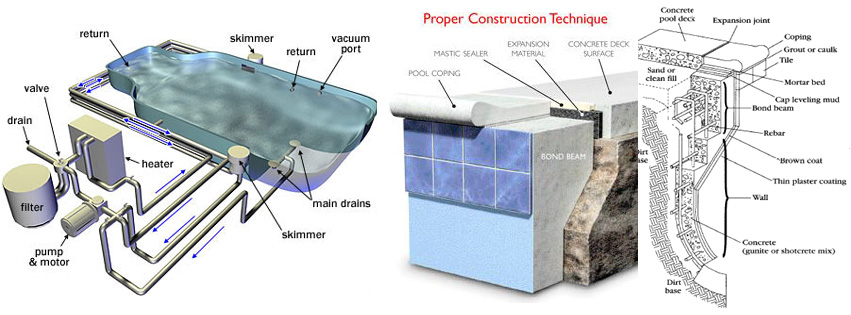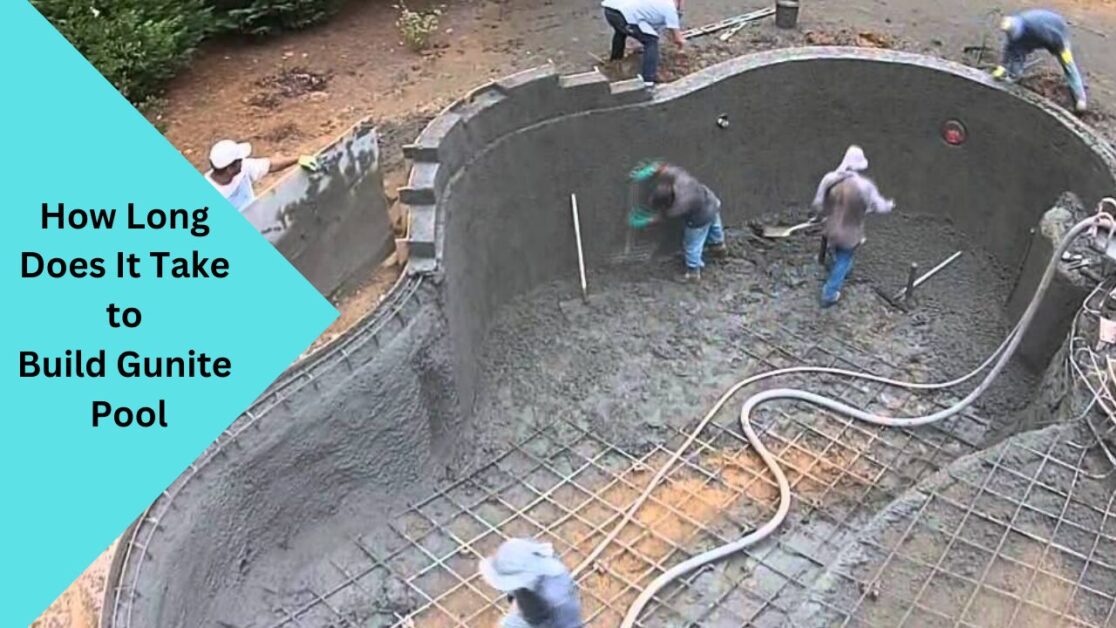Welcome to a comprehensive guide on building gunite pools and learning about the time it takes to bring your dream pool to life. Are you excited to dive into the process of constructing a gunite pool and eager to understand the timelines involved? If so, you’re in the right place! In this article, we’ll walk you through the entire process, discuss relevant factors, and answer common questions such as the lifespan of a gunite pool and the setting time for the concrete. So let’s jump right in!
Understanding Gunite Pools
Before exploring the construction timeline, let’s briefly understand what exactly a gunite pool is. Gunite refers to a mixture of dry cement and sand that gets sprayed onto a framework of steel rebar. This technique allows for the creation of highly durable and customized swimming pools. Gunite pools are known for their strength, longevity, and flexibility in design. If you’re looking for a pool that can withstand the test of time and blend seamlessly with your outdoor space, a gunite pool is an excellent choice.Go in Details by read complete article about What Are Gunite Pools – Unveiling the Wonders
Factors Affecting Construction Time
The time it takes to build a gunite pool depends on various factors. Understanding these factors will give you a better idea of how long the construction process might take.
- Pool Size and Complexity: The larger and more intricate your pool design, the longer it will typically take to construct. Features like waterfalls, custom shapes, and intricate tile work require additional time and attention to detail.
- Permits and Approvals: Before diving into the construction process, you’ll need to obtain the necessary permits and approvals from local authorities. The time it takes to secure these can vary depending on your location and local regulations.
- Site Preparation: Clearing the site, excavating, and preparing the ground for pool installation can take a significant amount of time, especially if there are obstacles to address, such as tree removal or uneven terrain.
- Seasonal Considerations: Weather conditions and seasonal demand can impact the construction timeline. Poor weather, such as heavy rainfall or freezing temperatures, may delay certain steps of the process.
Now that we have a good understanding of the factors influencing the construction time, let’s dive into the step-by-step process of building a gunite pool. To explore more details and considerations regarding How to Build a Gunite Pool, our comprehensive guide on How to Build a Gunite Pool: Step-by-Step Guide has you covered.
Step-by-Step Pool Building Process

Building a gunite pool involves several essential steps that ensure the pool is structurally sound and meets your design expectations. Let’s explore each step in detail.
-
Excavation and Layout
The first step is excavating the site and creating the pool’s shape in the ground. This involves removing soil and carefully shaping the area according to your desired pool design. Precise measurements and markings are made to ensure accuracy.
Pro tip:
Before excavating, ensure you’ve consulted with a professional pool builder or engineer who can assess the soil conditions and advise on any necessary precautions or adjustments.
-
Steel Reinforcement
Once the excavation is complete, steel rebar is installed to provide structural support to the pool. The rebar is carefully placed and secured according to engineering specifications, ensuring optimal strength and durability.
Pro tip:
Using quality steel reinforcement and following engineering guidelines is crucial for the long-term stability of your gunite pool. Cutting corners during this step can lead to structural problems down the line.
-
Plumbing and Electrical
After the steel reinforcement is in place, the plumbing and electrical components are installed. This includes:
- Plumbing lines for water circulation, filtration, and drainage
- Electrical wiring for pool lights, water features, and other electrical components
Proper installation of pipes and electrical connections ensures the functional aspects of your pool are efficient and meet safety requirements.
Pro tip:
Consult with a licensed plumber and electrician to ensure all plumbing and electrical work complies with local codes and regulations.
-
Gunite Application
Once the structural elements and utility connections are in place, it’s time for the exciting part – the gunite application. Gunite is a mixture of dry cement and sand, which is mixed with water on-site and sprayed onto the steel framework to create the pool’s shell.More about Exploring Gunite Pools: Pros and Cons
Pro tip:
Hiring experienced professionals who specialize in gunite application is highly recommended to ensure proper mixing, application, and finishing techniques.
-
Curing and Finishing
After the gunite application, the pool shell needs time to cure properly. This typically takes around 7 to 10 days, during which the gunite hardens and gains its full strength. After curing, the pool’s interior finish, such as tiles, plaster, or pebble aggregate, is applied, giving it a visually appealing and smooth surface.
Pro tip:
During the curing process, it’s essential to follow specific care instructions provided by your pool builder or contractor. This helps prevent damage to the gunite shell and ensures the longevity of your pool.
How Long Does It Take to Build a Gunite Pool?
Now that we have a clear understanding of the step-by-step pool building process, let’s dive into the anticipated timelines.
General Timeline
On average, it takes approximately 8 to 12 weeks to build a gunite pool from start to finish. However, keep in mind that this timeline can vary depending on different factors, as we discussed earlier.
Variations Based on Pool Complexity
The complexity of your pool design can significantly impact the construction time. Pools with unique features, intricate tile work, or extensive landscaping can take longer to complete. It’s important to discuss your design vision with your pool builder, who can provide a more accurate timeline based on the specifics of your project.
Climate and Seasonal Considerations
The climate and the season in which you choose to build your pool can affect the overall construction time. During extreme weather conditions or the peak pool-building season, there may be delays due to factors like heavy rain, freezing temperatures, or increased demand for pool builders’ services.
Hiring a Professional vs. DIY
While some homeowners opt for a do-it-yourself approach, hiring a professional pool builder can save time and ensure the highest quality construction. Professionals have the necessary experience, expertise, and equipment to complete the project efficiently. Moreover, they will handle the permits, coordinate with subcontractors, and ensure compliance with local regulations.
The Lifespan of a Gunite Pool
Now that we’ve covered the construction timeline, let’s address another frequently asked question: the lifespan of a gunite pool.
A well-maintained gunite pool can last for several decades. On average, gunite pools have a lifespan of 30 to 50 years. Factors such as regular maintenance, water chemistry balance, and attention to repairs play a vital role in prolonging the lifespan of your pool. By following proper maintenance guidelines and promptly addressing any issues that arise, you can enjoy your gunite pool for many years to come. To explore more details and considerations regarding life Spam, our comprehensive guide on How Long Do Gunite Pools Really Last? Unveiling the Truth. has you covered.
The Concrete Thickness of a Gunite Pool
A common concern when considering a gunite pool is the thickness of the concrete shell. The thickness varies depending on the pool’s design and engineering requirements, but it typically ranges between 6 and 8 inches. The reinforcing steel rebar within the concrete provides additional strength and structural integrity, ensuring the pool can withstand the water pressure and external forces.
The Setting Time of a Concrete Pool
After the gunite is applied, it requires sufficient time to cure and set properly before any further finishes can be added. The curing process typically takes around 7 to 10 days, during which the gunite achieves its full strength. It’s crucial to follow the recommended curing procedures provided by your pool builder to ensure optimal durability and performance.
Conclusion
Congratulations on reaching the end of this comprehensive guide on building a gunite pool and understanding the time it takes to bring your dream pool to life. Planning and constructing a gunite pool is an exciting journey, and now you have a solid understanding of the process, timelines, and factors involved. Remember, the construction time can vary based on the pool’s complexity, permits, and weather conditions. Hiring a professional pool builder and following proper maintenance guidelines will help ensure the longevity of your gunite pool. So, dive into this exciting project and enjoy the countless memorable moments that await you in your very own gunite pool!

Greetings, fellow pool enthusiasts! I’m Turner Davis, your dedicated guide to the world of pool care and maintenance. With over a decade of experience in the field, I’ve made it my mission to transform ordinary pools into extraordinary aquatic retreats.

